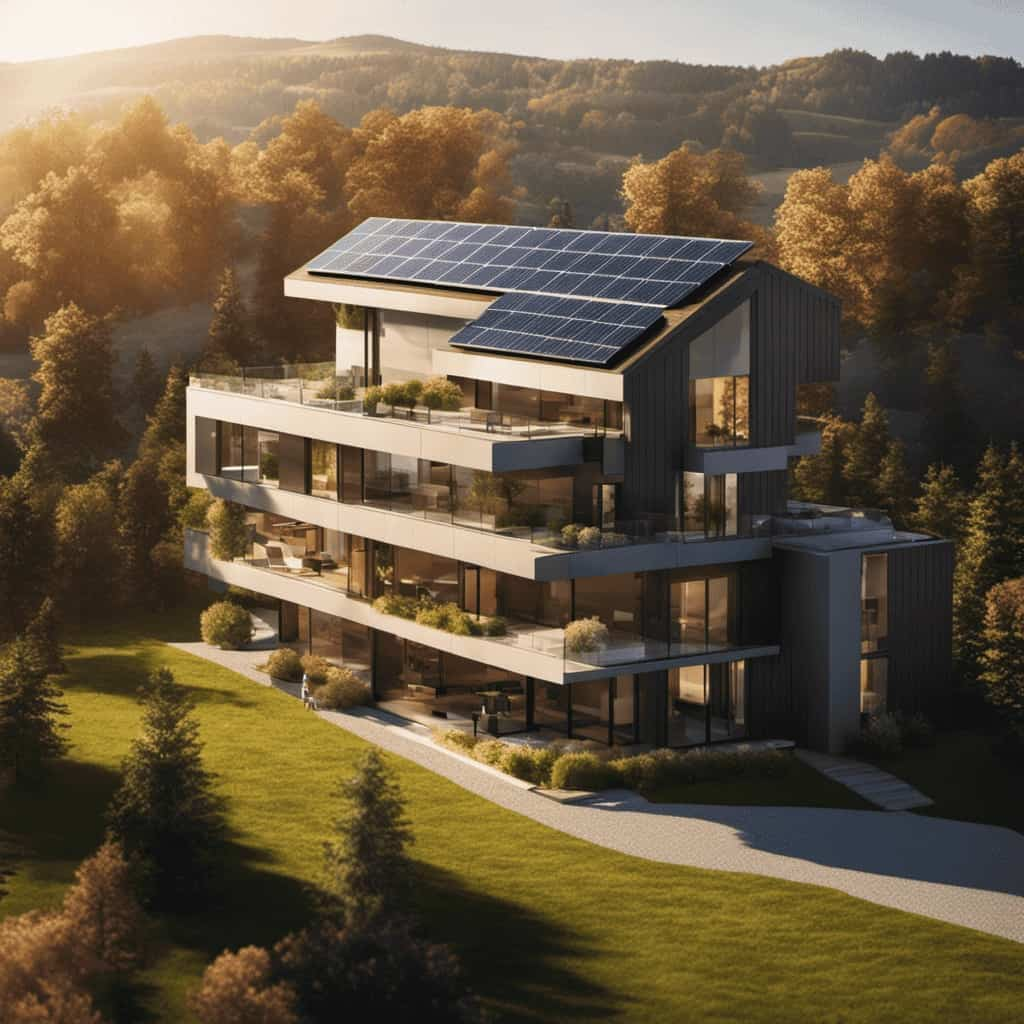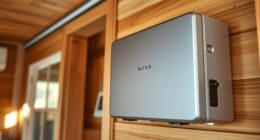We offer the newest high-efficiency heat pumps that can help you save both energy and money.
In this article, we’ll delve into the technical details of these innovative systems.
We’ll explain the importance of efficiency ratings like SEER and HSPF, introduce you to top-rated brands, and highlight the energy saving features you should look for.
With our tips and insights, you’ll be able to maximize energy savings and make a positive impact on the environment.
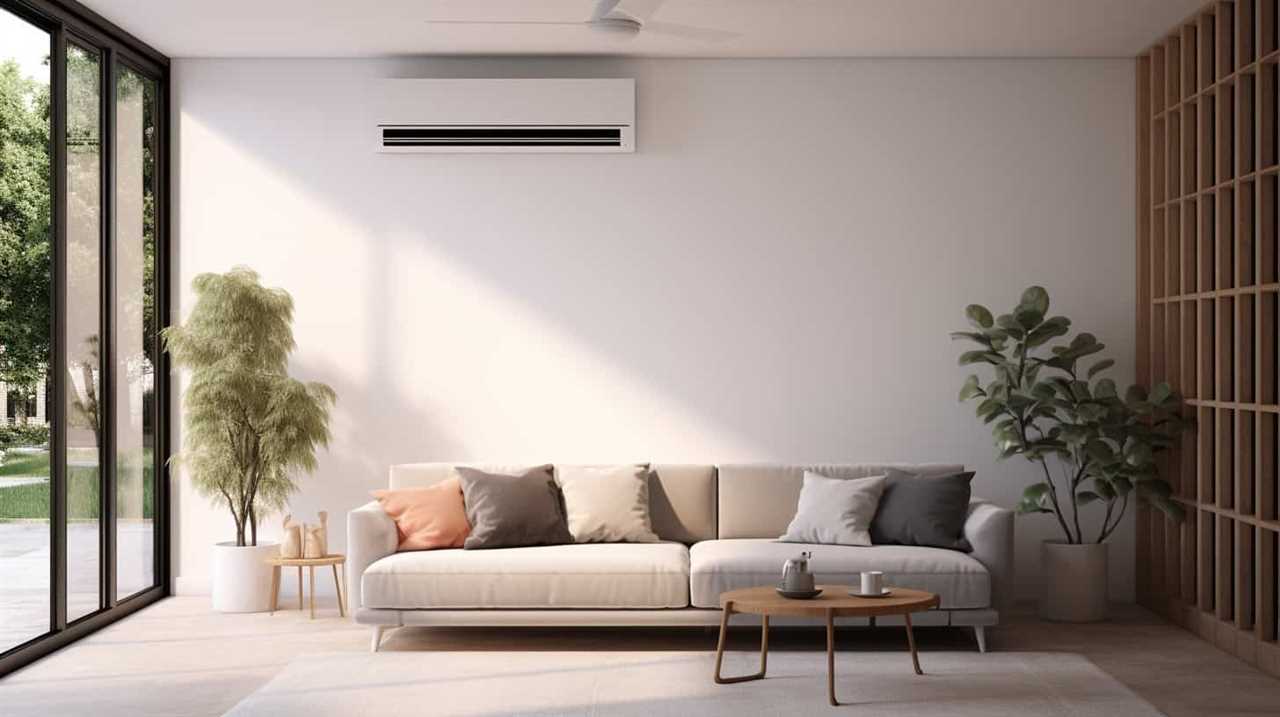
Let’s dive in!
Key Takeaways
- SEER and HSPF ratings determine the efficiency of heat pumps, with higher ratings indicating better cooling and heating efficiency respectively.
- Carrier, Trane, Lennox, and Rheem are top-rated brands for energy efficiency and offer advanced technologies for optimal performance.
- Investing in high efficiency heat pumps from these brands leads to significant energy savings and contributes to a greener and more sustainable future.
- Energy-saving features such as variable-speed compressors, multi-stage systems, renewable energy compatibility, and programmable thermostats are key factors in achieving energy savings with high efficiency heat pumps.
Efficiency Ratings: Understanding SEER and HSPF
When it comes to understanding SEER and HSPF efficiency ratings, we need to consider their impact on energy savings. These ratings are essential in determining the efficiency of heat pumps, which ultimately affects how much energy is consumed and how much money can be saved.
SEER, or Seasonal Energy Efficiency Ratio, measures the cooling efficiency of a heat pump. The higher the SEER rating, the more efficient the heat pump is in cooling your home.
On the other hand, HSPF, or Heating Seasonal Performance Factor, measures the heating efficiency of a heat pump. A higher HSPF rating means greater heating efficiency.
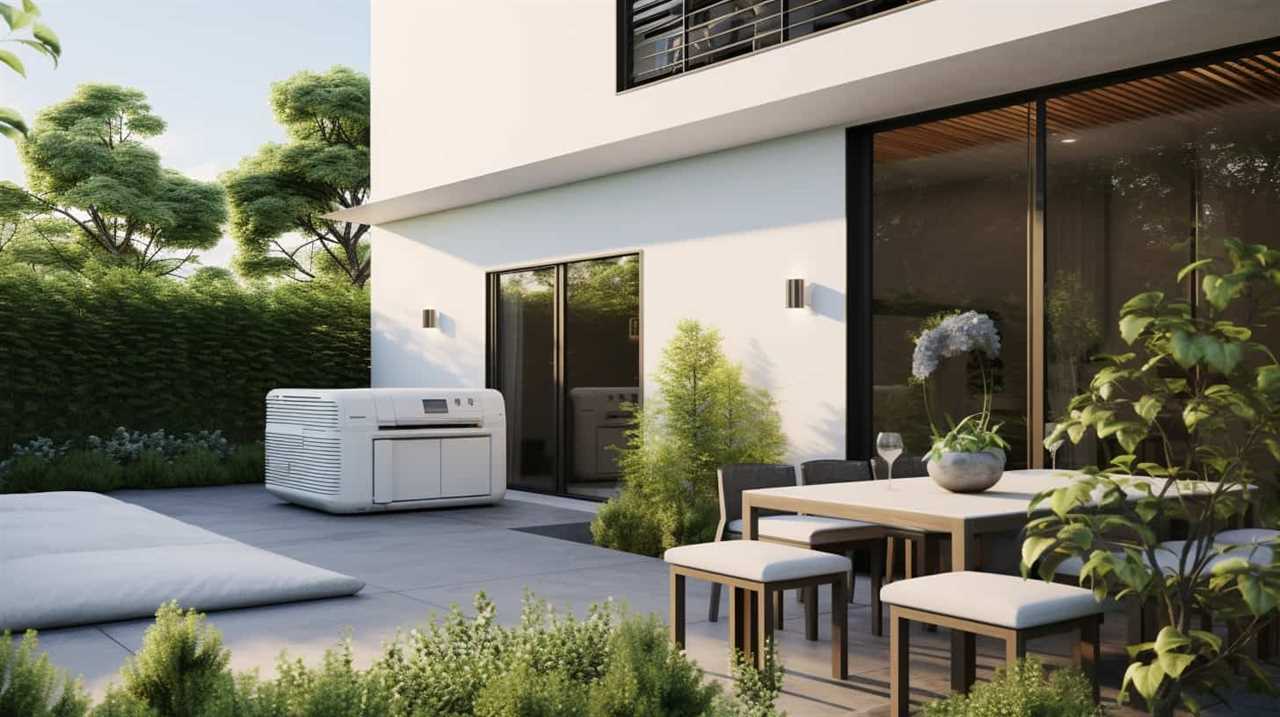
Heat pump design plays a crucial role in achieving higher efficiency ratings. Variable speed technology, for instance, allows the heat pump to adjust its output based on the heating or cooling needs of the space, resulting in optimized energy consumption and savings.
Understanding these efficiency ratings and the technology behind heat pump design can help homeowners make informed decisions when choosing the most energy-efficient option for their homes.
Top-Rated Brands for Energy Efficiency
For our review of top-rated brands for energy efficiency, we’ve selected the most reliable and cost-effective options on the market. These top rated brands have been recognized for their exceptional energy saving benefits.
When it comes to choosing a high efficiency heat pump, it’s important to consider the brand’s reputation, reliability, and performance. Some of the top rated brands in the market include Carrier, Trane, Lennox, and Rheem. These brands have consistently delivered high quality heat pumps that offer significant energy savings for homeowners.
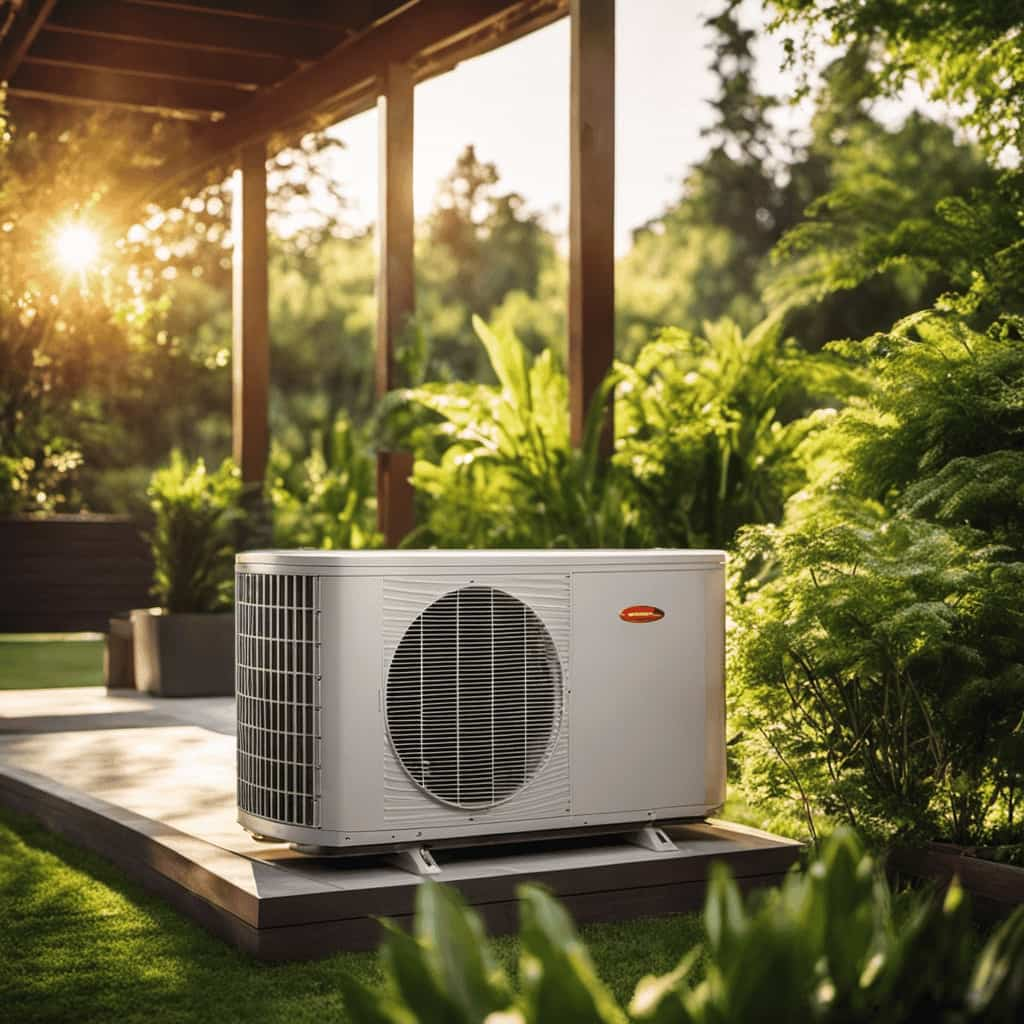
With advanced technologies and innovative features, these brands ensure optimal performance and maximum energy efficiency. Investing in a high efficiency heat pump from one of these top rated brands won’t only help you save on your energy bills but also contribute to a greener and more sustainable future.
Now, let’s explore the benefits of investing in a high efficiency heat pump.
Benefits of Investing in a High Efficiency Heat Pump
Investing in a high efficiency heat pump brings several benefits.
Firstly, it can significantly lower energy bills by reducing the amount of electricity needed for heating and cooling.

Secondly, it promotes environmental sustainability by consuming less energy and reducing greenhouse gas emissions.
Lastly, a high efficiency heat pump enhances home comfort by providing consistent and even heating or cooling throughout the year.
These advantages make investing in a high efficiency heat pump a wise choice for homeowners looking to save money, reduce their carbon footprint, and improve their overall comfort.
Lower Energy Bills
We can save money on our energy bills by upgrading to a high efficiency heat pump. Here are three reasons why investing in a high efficiency heat pump can lead to lower energy bills:

-
Lower Energy Consumption: High efficiency heat pumps are designed to use less energy while still providing the same level of heating or cooling as traditional models. This means that they can effectively maintain a comfortable indoor temperature while consuming less electricity. By reducing energy consumption, homeowners can see a significant decrease in their monthly energy bills.
-
Energy Efficient Technologies: High efficiency heat pumps incorporate advanced technologies that maximize energy efficiency. These technologies include variable-speed compressors, smart thermostats, and improved insulation. By utilizing these energy efficient technologies, high efficiency heat pumps can optimize performance and minimize energy waste, resulting in lower energy bills.
-
Potential Rebates and Incentives: In many regions, there are government programs and incentives that encourage homeowners to invest in energy efficient appliances, including high efficiency heat pumps. These programs often offer rebates or tax credits that can offset the initial cost of the heat pump installation. By taking advantage of these incentives, homeowners can’t only lower their energy bills but also recoup some of their investment.
Investing in a high efficiency heat pump is a smart choice for homeowners who want to lower their energy bills. These heat pumps offer lower energy consumption, incorporate energy efficient technologies, and may come with potential rebates and incentives. By upgrading to a high efficiency heat pump, homeowners can enjoy both cost savings and environmental benefits.

Environmental Sustainability
By choosing a high efficiency heat pump, we can contribute to environmental sustainability by reducing our carbon footprint. High efficiency heat pumps are designed to consume less energy than traditional heating systems, resulting in lower greenhouse gas emissions. This is beneficial for the environment as it helps to combat climate change and reduce air pollution.
Moreover, high efficiency heat pumps support green building and sustainable living practices by promoting energy efficiency and conservation. These heat pumps utilize advanced technologies such as variable speed compressors and smart thermostats to optimize performance and reduce energy consumption.
Increased Home Comfort
Our home’s comfort can be greatly increased with the installation of a high efficiency heat pump. Investing in a high efficiency heat pump offers several benefits that contribute to a more comfortable living environment. Here are three key advantages:
-
Consistent Temperature Control: A high efficiency heat pump ensures a consistent and even distribution of warm or cool air throughout the home. This eliminates hot or cold spots and provides a comfortable atmosphere in every room.

-
Improved Indoor Air Quality: High efficiency heat pumps have advanced filtration systems that remove airborne contaminants such as dust, pollen, and allergens. As a result, the air inside your home is cleaner and healthier, leading to increased comfort for you and your family.
-
Reduced Noise Levels: High efficiency heat pumps are designed to operate quietly, minimizing disruptions and creating a peaceful living environment.
By investing in a high efficiency heat pump, you can enjoy increased home comfort while also reducing energy consumption and minimizing the impact on your HVAC system.
Now let’s explore the energy saving features to look for in heat pumps.

Energy Saving Features to Look for in Heat Pumps
When it comes to energy-saving features in heat pumps, there are a few key points to consider.
Firstly, look for heat pumps that offer top energy-saving features such as variable-speed compressors and advanced control systems. These features allow the heat pump to adjust its output according to the heating or cooling needs, resulting in optimal energy efficiency.
Additionally, consider cost-effective efficiency options like two-stage compressors and multi-stage systems, which provide better energy savings without compromising comfort.
Top Energy-Saving Features
Let’s explore the top energy-saving features to look for in heat pumps.

When it comes to cost-effective efficiency options, heat pumps with variable speed compressors are highly recommended. These compressors adjust their speed according to the heating or cooling demands of the space, resulting in reduced energy consumption and lower utility bills.
Another important energy-saving feature to consider is the presence of a two-stage or multi-stage heating and cooling system. These systems operate at different levels of output depending on the temperature requirements, providing better comfort and improved energy efficiency.
Lastly, renewable energy compatibility is a key feature to look for in heat pumps. Some models are designed to work seamlessly with solar panels or geothermal systems, allowing you to harness clean and sustainable energy sources. By utilizing renewable energy, you can further reduce your carbon footprint and achieve significant energy savings.
Cost-Effective Efficiency Options
We should consider cost-effective efficiency options when looking for energy-saving features in heat pumps. By choosing the right cost-effective options and energy efficient upgrades, we can maximize energy savings and reduce our carbon footprint. Here are some key features to look for:
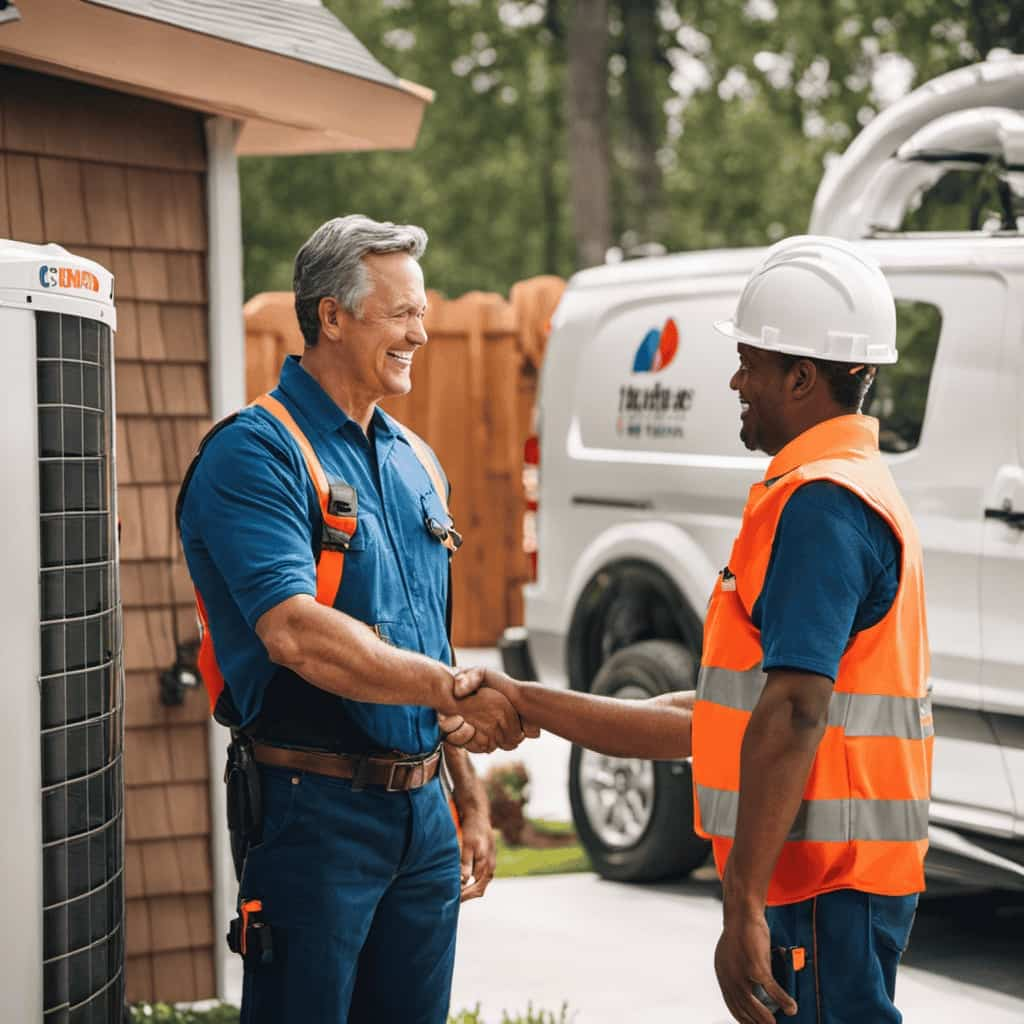
| Cost-Effective Efficiency Options | Benefits |
|---|---|
| Programmable Thermostat | Allows for precise temperature control and scheduling, optimizing energy usage |
| Energy Star Certification | Ensures that the heat pump meets strict energy efficiency guidelines |
| Two-stage Compressor | Provides better temperature control and reduces energy consumption |
| Variable-Speed Blower Motor | Adjusts airflow based on heating and cooling needs, improving efficiency |
These cost-effective options not only help save energy and money, but also contribute to a more sustainable future. Transitioning to the next section, let’s now explore the role of variable-speed technology in further enhancing energy efficiency.
The Role of Variable-Speed Technology in Energy Efficiency
Variable-speed technology significantly improves energy efficiency in heat pumps, allowing us to optimize performance and reduce energy consumption. Here are three key benefits of variable-speed technology in heat pumps:
-
Enhanced Efficiency: Variable-speed technology adjusts the speed of the compressor and fan motor based on the heating or cooling demands of the space. This flexibility allows the heat pump to operate at lower speeds when less heating or cooling is required, resulting in reduced energy consumption.
-
Improved Comfort: By operating at variable speeds, heat pumps with variable-speed technology can maintain a more consistent and precise indoor temperature. This eliminates temperature fluctuations and provides a more comfortable living environment.
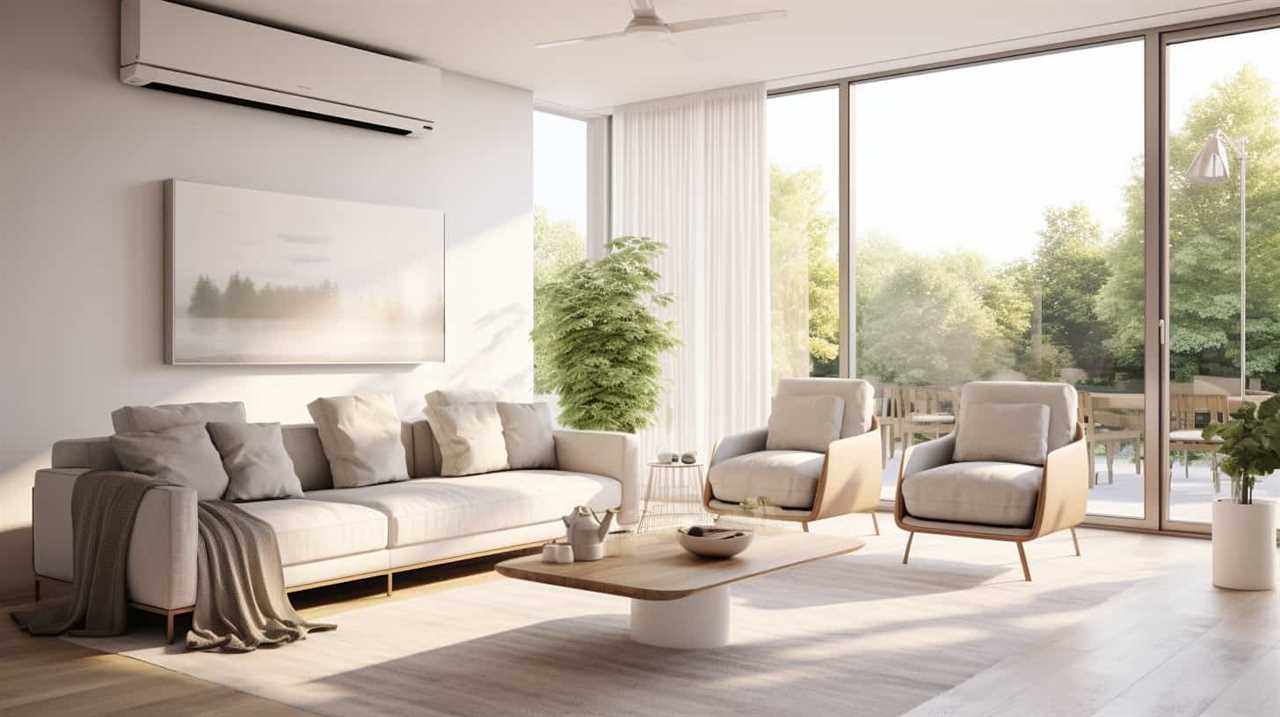
-
Quieter Operation: Variable-speed technology allows heat pumps to operate at lower speeds, resulting in reduced noise levels compared to traditional single-speed models. This quieter operation enhances the overall comfort and tranquility of the space.
As we explore the innovations in heat pump design for maximum energy savings, we’ll see how these advancements further contribute to energy efficiency and cost savings.
Innovations in Heat Pump Design for Maximum Energy Savings
When it comes to innovations in heat pump design for maximum energy savings, there are several key points to consider.
One important aspect is improved insulation, which helps to minimize heat loss and improve overall efficiency.
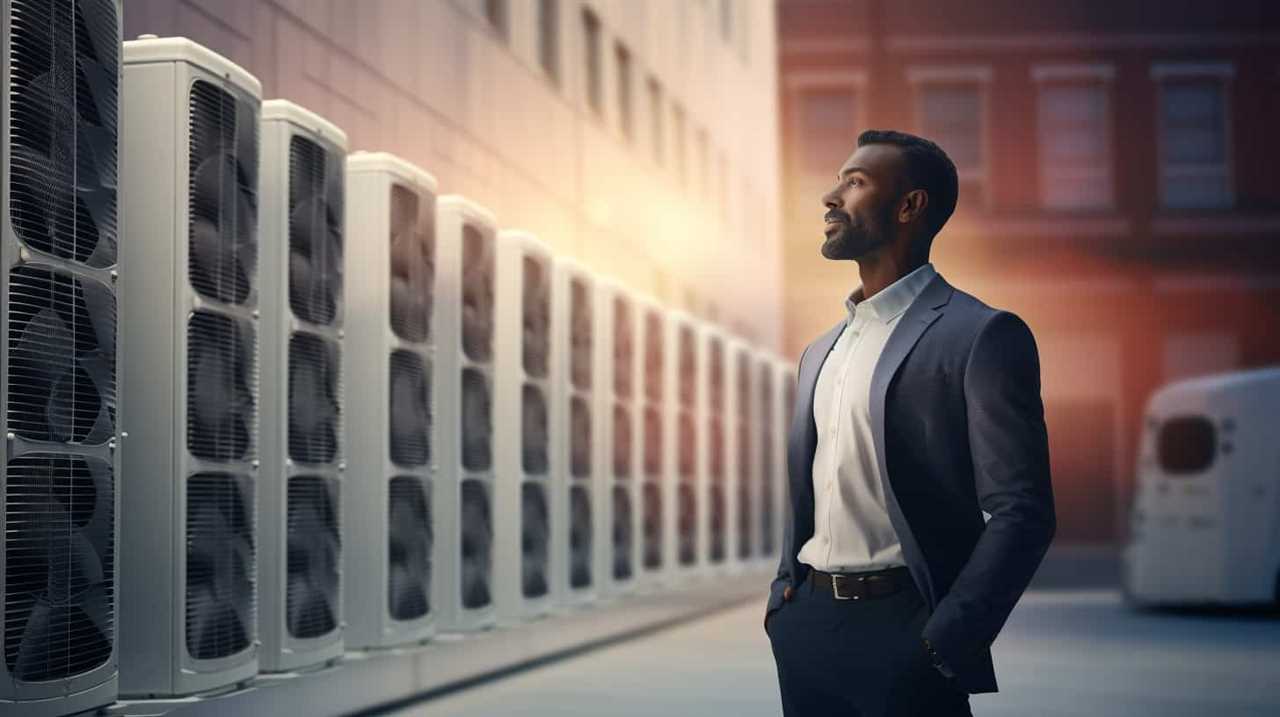
Another point to highlight is the integration of smart thermostats, which allow for more precise temperature control and better energy management.
Lastly, the compatibility of heat pumps with renewable energy sources is a crucial innovation, as it enables the use of clean and sustainable power for heating and cooling purposes.
These advancements in heat pump design contribute to significant energy savings and a more sustainable future.
Improved Insulation for Efficiency
With the use of advanced materials and techniques, our team has developed heat pump designs that incorporate improved insulation for maximum energy savings. This innovation in heat pump design focuses on enhancing insulation techniques and utilizing energy efficient construction materials.

Here are three key features of our improved insulation for efficiency:
-
Enhanced Insulation Materials: Our heat pump designs utilize high-performance insulation materials, such as polyurethane foam and fiberglass, to minimize heat transfer and maximize energy efficiency. These materials have superior thermal resistance properties, reducing energy loss and improving overall system performance.
-
Air-tight Construction: Our heat pump units are constructed with precision to ensure a tight seal, minimizing air leakage and heat loss. By eliminating drafts and maintaining a consistent temperature, our heat pumps can operate more efficiently and effectively.
-
Insulation Placement: We strategically place insulation in critical areas of the heat pump to minimize thermal bridging and heat loss. By insulating key components, such as the compressor and refrigerant lines, we reduce energy waste and optimize the heat pump’s performance.
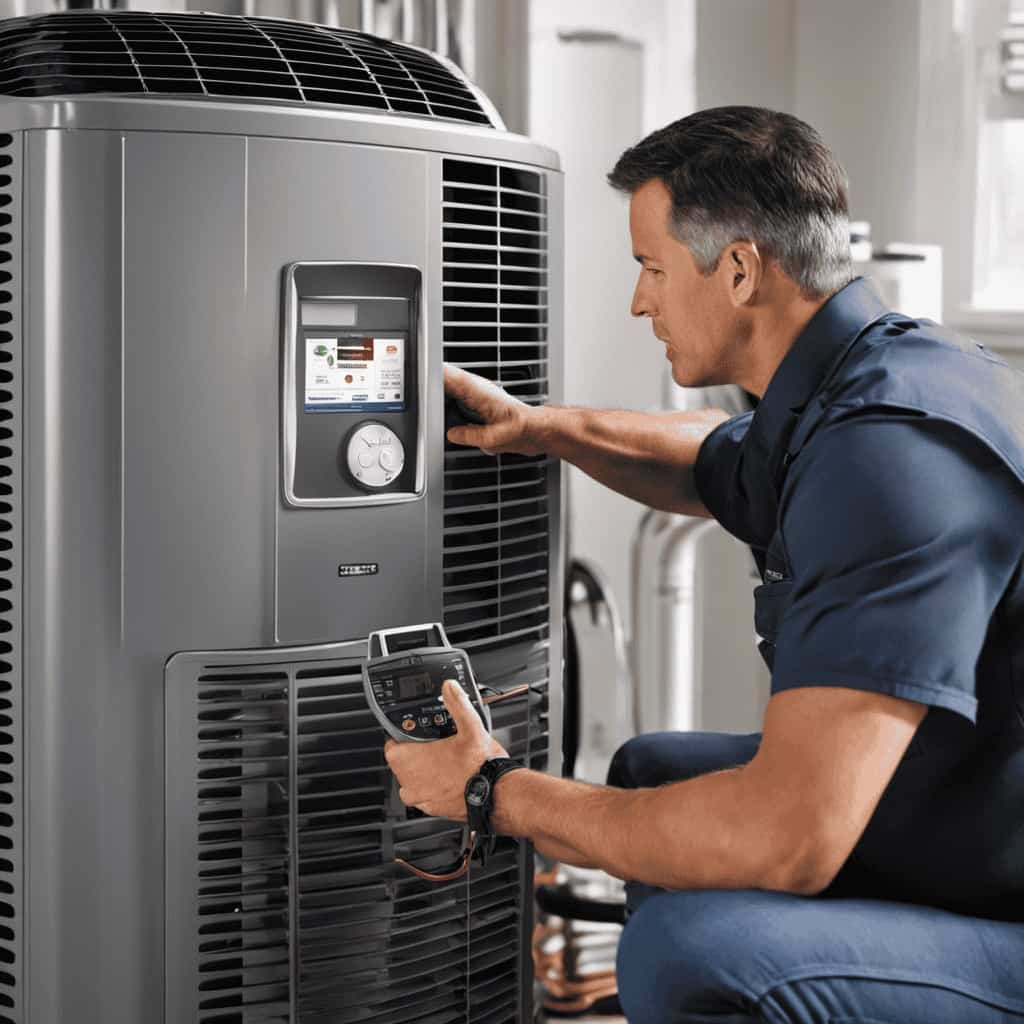
By incorporating these improved insulation techniques and energy efficient construction materials, our heat pump designs provide maximum energy savings and enhanced performance.
This lays the foundation for the subsequent section on smart thermostat integration, which further optimizes energy usage and comfort control.
Smart Thermostat Integration
We have implemented smart thermostat integration as an innovative way to optimize energy savings in our heat pump designs.
Smart home integration allows for seamless communication between the heat pump and the thermostat, enabling precise control over temperature settings and energy management.
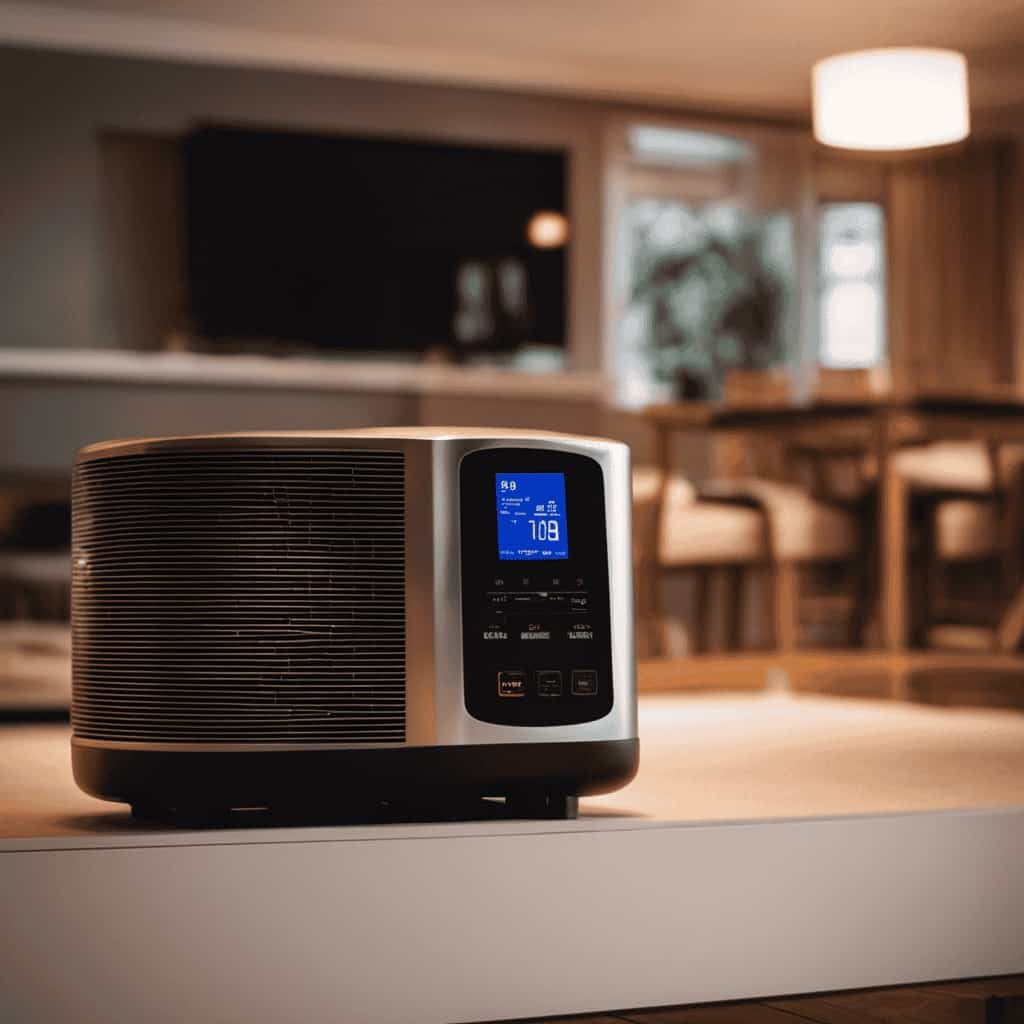
With this integration, homeowners can remotely adjust their heating and cooling preferences through their smartphones or other smart devices.
By using advanced algorithms and machine learning, the smart thermostat can learn the occupants’ behavior and make automatic adjustments to optimize energy usage.
It can also consider factors such as weather forecasts and occupancy patterns to further enhance energy efficiency.
This level of control and automation ensures that the heat pump operates at its highest efficiency, reducing energy consumption and ultimately saving homeowners money on their utility bills.
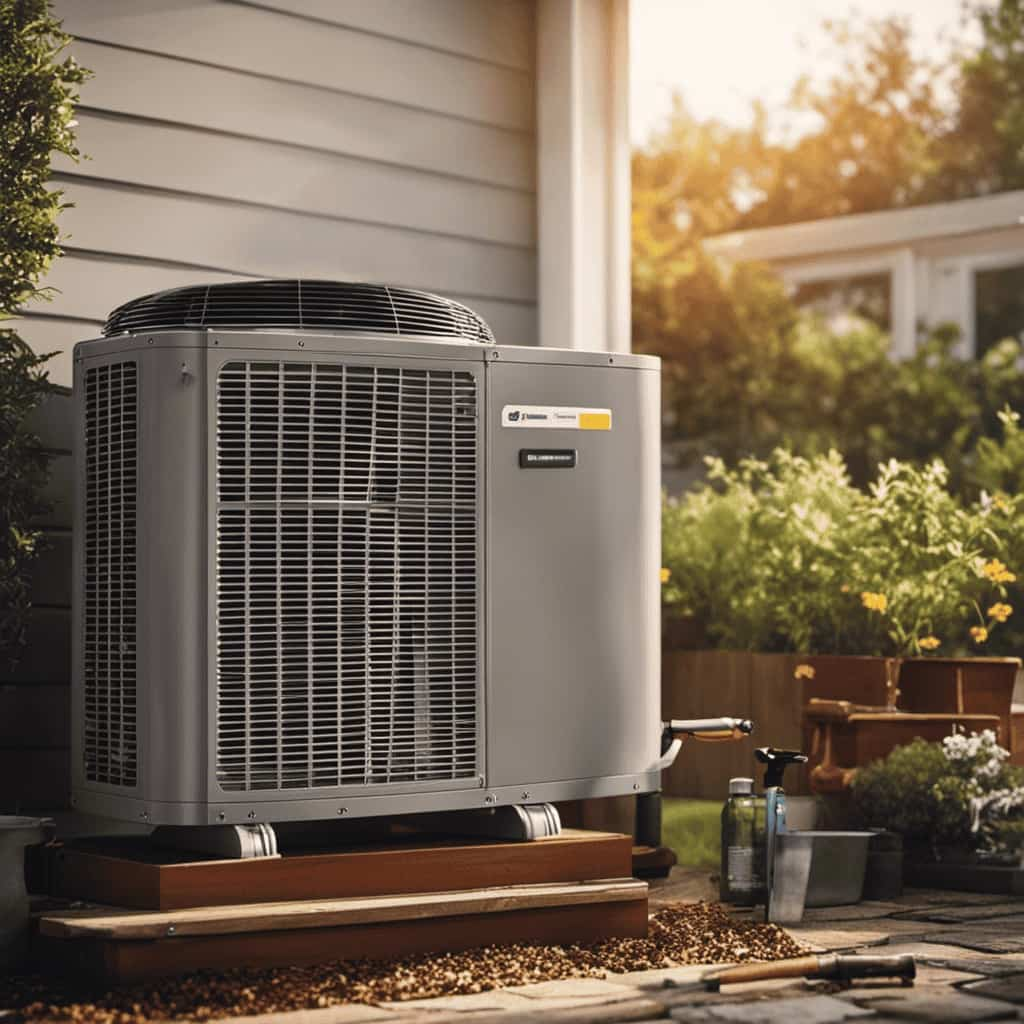
Renewable Energy Compatibility
To maximize energy savings, our heat pump designs have been innovatively designed to be compatible with renewable energy sources. Here are three key features that make our heat pumps highly compatible with renewable energy:
-
Renewable Energy Incentives: Our heat pumps are designed to work seamlessly with renewable energy sources such as solar panels and wind turbines. By utilizing these sources, homeowners can take advantage of various renewable energy incentives and reduce their reliance on traditional energy sources.
-
Energy Storage Solutions: We understand that renewable energy sources can be intermittent. That’s why our heat pumps are equipped with energy storage solutions, such as batteries, to store excess energy and ensure a continuous supply of heating and cooling.
-
Smart Grid Integration: Our heat pumps can be integrated into smart grids, allowing them to communicate with the utility grid and optimize energy consumption. This helps to further increase energy efficiency and reduce overall energy costs.

By incorporating these features, our heat pumps not only maximize energy savings but also contribute to a more sustainable and environmentally friendly future.
Transitioning to the next section, let’s now explore how proper sizing impacts energy efficiency in heat pumps.
How Proper Sizing Impacts Energy Efficiency in Heat Pumps
Proper sizing plays a crucial role in improving energy efficiency in heat pumps. When a heat pump isn’t sized correctly, it can lead to several issues that negatively impact its energy consumption.
If the heat pump is too small, it will have to work harder and run for longer periods to meet the heating or cooling demands of the space. This results in increased energy consumption and higher utility bills.

On the other hand, if the heat pump is oversized, it will short cycle, turning on and off frequently, which also leads to energy wastage. Therefore, it’s essential to properly size heat pumps to ensure optimal energy efficiency and reduce energy consumption.
By doing so, homeowners can enjoy lower energy bills while maintaining a comfortable indoor environment.
Transitioning into the next section, achieving optimal performance with regular maintenance is equally important in maximizing energy efficiency in heat pumps.
Achieving Optimal Performance With Regular Maintenance
Our regular maintenance is key to achieving optimal performance with our heat pumps. By following a proper maintenance checklist, we can ensure that our heat pumps continue to operate efficiently and effectively.
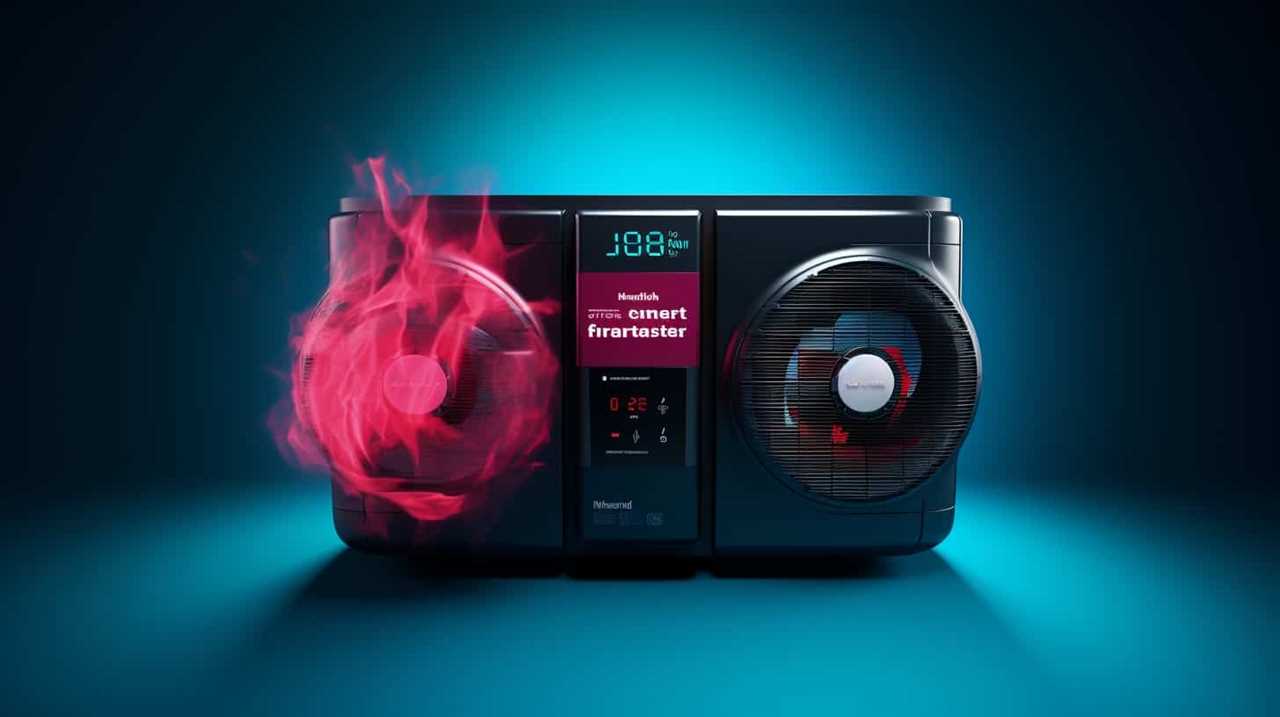
Here are three important maintenance tasks that should be included in our checklist:
-
Regular filter cleaning: Dirty filters restrict airflow and reduce the heat pump’s efficiency. Cleaning or replacing the filters every one to three months is essential for maintaining proper airflow and preventing dust and debris buildup.
-
Coil cleaning: Over time, the outdoor coils of our heat pumps can accumulate dirt and debris, hindering heat transfer. Regularly cleaning the coils with a gentle spray of water can improve efficiency and prevent potential damage.
-
Lubrication of moving parts: The various moving parts of our heat pumps, such as fan motors and bearings, require lubrication to reduce friction and ensure smooth operation. Regularly lubricating these parts according to manufacturer guidelines can help prolong the lifespan of our heat pumps and maintain optimal performance.

Exploring the Connection Between Energy Efficiency and Indoor Air Quality
Three key factors affect the connection between energy efficiency and indoor air quality.
The first factor is the proper design and installation of the HVAC system. A well-designed system ensures that the air is distributed evenly throughout the building, preventing hot or cold spots and maintaining a comfortable indoor environment. It also includes features such as air filtration and ventilation systems that improve indoor air quality by removing pollutants and promoting fresh air exchange.
The second factor is regular maintenance and cleaning of the HVAC system. This includes changing air filters regularly, cleaning air ducts, and inspecting and cleaning the outdoor unit. Proper maintenance not only improves energy efficiency by keeping the system running smoothly, but it also helps to remove accumulated dirt, dust, and allergens from the indoor air, enhancing indoor air quality.
The third factor is the use of energy-efficient appliances and equipment. High-efficiency heat pumps, for example, not only provide effective heating and cooling but also consume less energy, resulting in lower utility bills. By using energy-efficient appliances and equipment, not only are energy savings achieved, but the overall indoor air quality is also improved as these appliances are designed to minimize pollutants and maximize air quality.
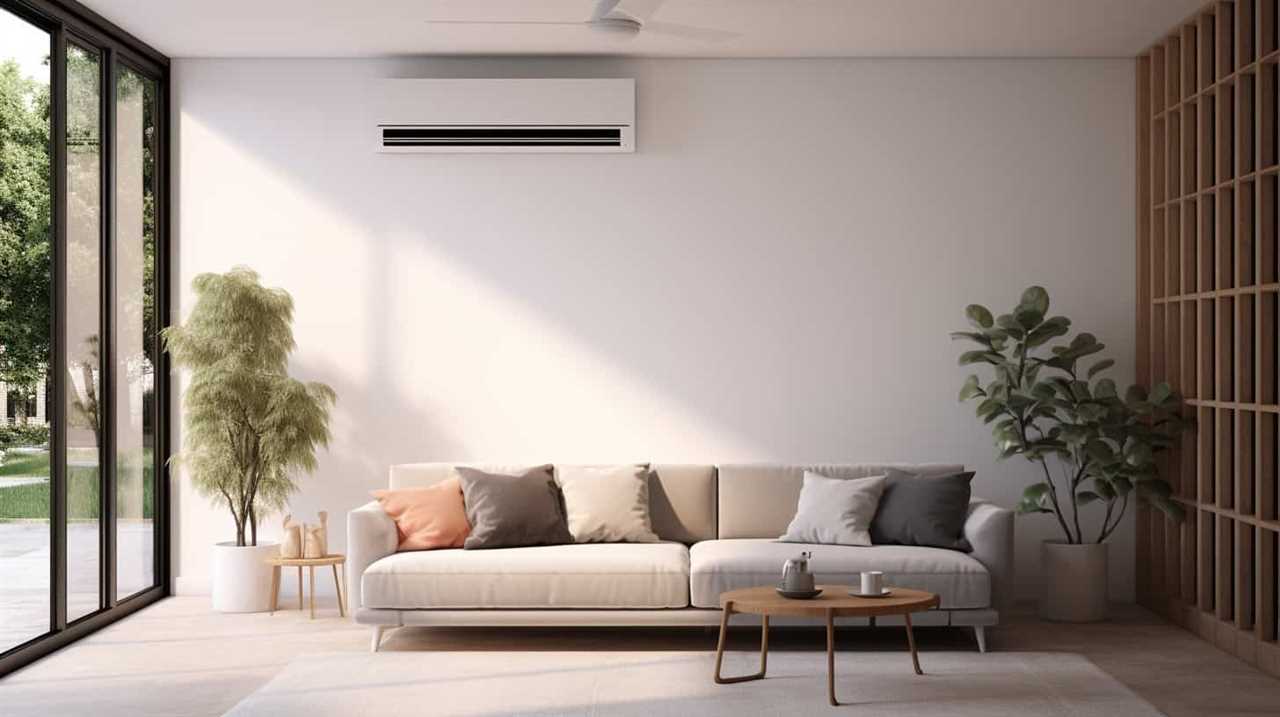
Government Incentives for Upgrading to High Efficiency Heat Pumps
We can save money and reduce our carbon footprint by upgrading to high efficiency heat pumps. The government offers incentives to encourage this transition. Here are three government incentives that provide financial assistance for upgrading to high efficiency heat pumps:
-
Tax Credits: The government offers tax credits to homeowners who install high efficiency heat pumps. These credits can help offset the upfront costs of purchasing and installing the new system.
-
Rebates: Many utility companies and local governments offer rebates for upgrading to high efficiency heat pumps. These rebates provide a financial incentive for homeowners to make the switch and can help lower the overall cost of the upgrade.
-
Financing Programs: In addition to tax credits and rebates, the government also provides financing programs that offer low-interest loans or grants for purchasing and installing high efficiency heat pumps. These programs make it more affordable for homeowners to invest in energy-efficient heating and cooling systems.

Tips for Maximizing Energy Savings With Your Heat Pump
To maximize energy savings with your heat pump, follow these four tips.
First, regular maintenance is crucial for optimal performance. Clean or replace air filters every one to three months and ensure that the outdoor unit is free of debris.
Second, check and seal any air leaks in your home to prevent energy loss.
Third, set your thermostat to the most energy-efficient temperature that still provides comfort.
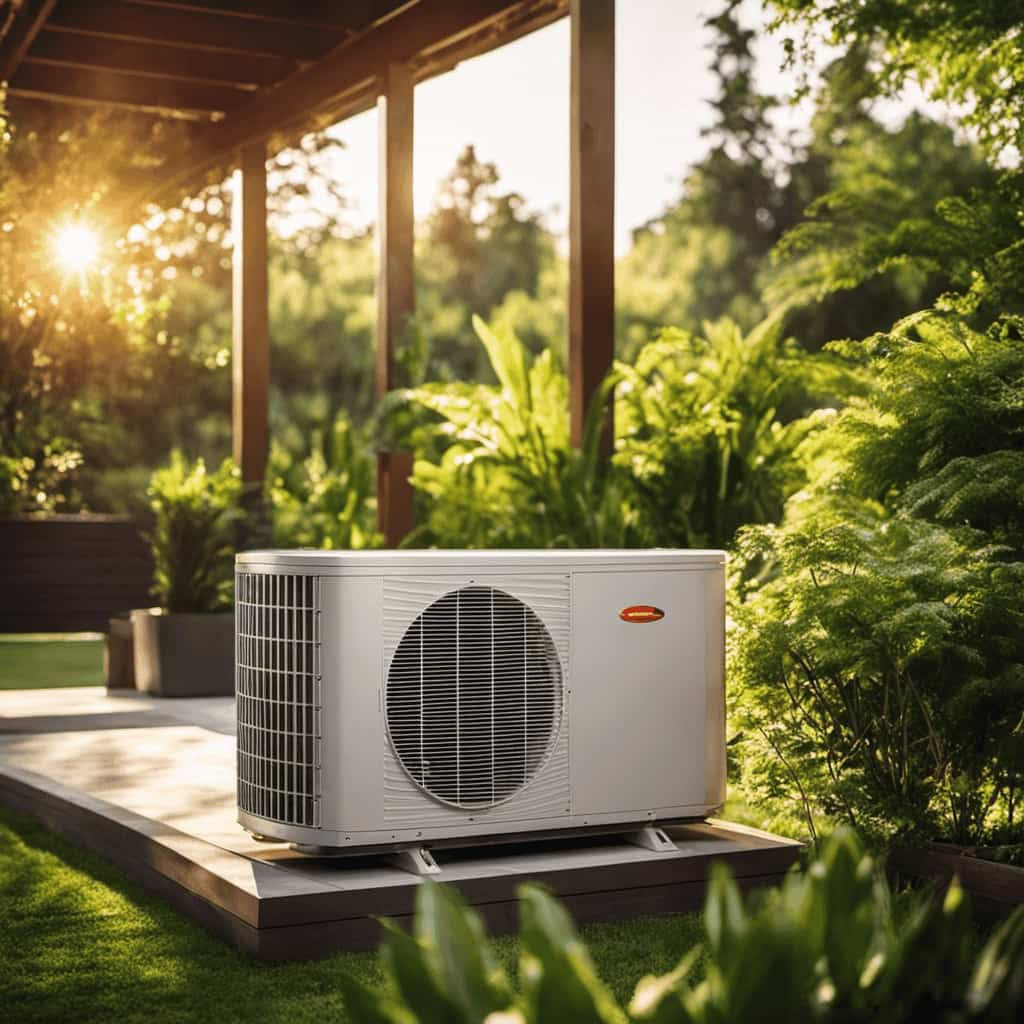
Finally, if you experience any issues with your heat pump, troubleshoot before calling for professional help. Check for power supply issues, inspect the circuit breaker, and ensure that the thermostat is set correctly.
Frequently Asked Questions
Can a High Efficiency Heat Pump Help Lower My Utility Bills?
Yes, a high efficiency heat pump can lower our utility bills. It is important to consider the pros and cons of these pumps and factors such as installation costs and energy savings before investing in one.
How Long Can I Expect a High Efficiency Heat Pump to Last?
On average, high efficiency heat pumps can last for 15-20 years with regular maintenance. These systems require regular filter cleaning, annual inspections, and occasional repairs to ensure optimal performance and longevity.
Are There Any Tax Credits or Rebates Available for Purchasing a High Efficiency Heat Pump?
Tax incentives and rebates are available for purchasing high efficiency heat pumps, providing potential energy savings. These incentives encourage homeowners to invest in more efficient systems, ultimately reducing energy consumption and lowering utility bills.

Can a High Efficiency Heat Pump Improve the Air Quality in My Home?
Yes, a high efficiency heat pump can improve the air quality in our home by improving ventilation and reducing indoor pollutants. This ensures a healthier and more comfortable living environment for all of us.
What Is the Average Cost of Installing a High Efficiency Heat Pump?
The average cost of installing a high efficiency heat pump can vary depending on factors such as the size of the unit and the complexity of the installation process. A cost comparison can help determine the best option for your home.
Conclusion
In conclusion, investing in the latest high efficiency heat pumps can provide significant energy savings and contribute to a more sustainable future.
By understanding efficiency ratings, choosing top-rated brands, and looking for energy-saving features, homeowners can maximize their energy savings.

Regular maintenance and the use of variable-speed technology further enhance the performance of heat pumps.
Additionally, the connection between energy efficiency and indoor air quality shouldn’t be overlooked.
Government incentives can also provide added motivation for upgrading to high efficiency heat pumps.
Follow these tips to maximize energy savings with your heat pump.

